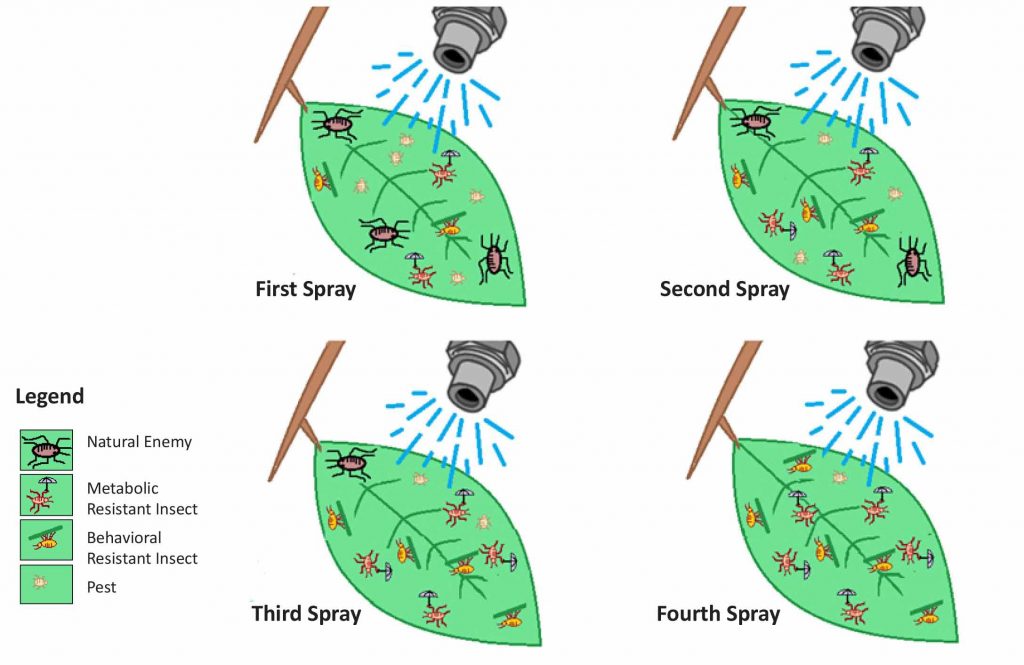
Features
Crop Protection
Inputs
Environmental Stewardship With an IPM Focus
The new super bugs causing problems in the greenhouse can be effectively managed by applying biologically based pest management strategies.
August 10, 2016 By Dr. Abida Nasreen
 Fig1. A conceptual pattern how pesticide resistant insects increased in numbers.
Fig1. A conceptual pattern how pesticide resistant insects increased in numbers. September 2016 – Insects pose one of the greatest challenges to humans when it comes to crop production and human health.
We have struggled with insects over evolutionary time because of their short life cycles and high
fecundity that allow them to withstand control measures in a very small amount of time. This evolutionary process enables the insects to develop heritable traits to overcome techniques used to manage pests.
Development of these traits results in the resistance of insects from chemical control methods by a change in behaviour, maturation, or biochemical processes. Insects can develop either a behavioural resistance or a metabolic resistance to pesticides.
In behavioural resistance, insects escape pesticide exposure by learning to stop feeding, hiding under a shelter, avoiding the targeted site, or escaping from treated areas. However, in metabolic resistance, insects develop the ability to detoxify the toxins by binding them to proteins in their bodies; these insects possess more efficient enzymes that break down the pesticides into non-toxic compounds.
This evolutionary process to exhibit resistance is very low in natural enemies. The reason for this might be due to differences in biology, ecology, and behaviour exhibited by the insect pests and natural enemies.
For example, insect pests have already developed mechanisms to fight or survive plant defence systems whereas natural enemies have never been given the opportunity to develop such mechanisms due to long life cycle, and lower fecundity and in numbers than pests.
Furthermore, the application of pesticides reduces the food supplies of natural enemies while there is plenty of food available for the survived insect pest. As a result, most of the natural enemies starve to death or are left with very low fecundity and predation capacity if they survive. Due to this reason, it is very rare for natural enemies to develop an evolutionary process and resistance to pesticides.
There is an increased abundance of insect pests with pesticide resistance in areas with a concentrated greenhouse industry like Leamington, Ont. Since a copious amount of the resistant pest population is flying around in the environment, it is very difficult for farmers to stop or reduce the growth of these insects even after applying biologically based Integrated Pest Management (IPM) strategies.
For instance, a farmer who carefully integrates different insect control methods will have a very low population of pesticide resistant pests.
However, a farmer who completely relies on chemicals to control the pests in his greenhouse will end up with a crop that consists of a fairly high population of insect pests, especially during the termination of the crop.
At this point, no one can stop these insect pests that have survived multiple rounds of pesticide sprays. They will have very high levels of pesticide resistance and are known as superbugs. Today, farmers observe such superbugs in the form of whiteflies, thrips, spider mites, and aphids.
All hope is not lost, however.
These superbugs can be managed by applying biologically based pest management strategies. Biologically based IPM suggests starting the pest control by introducing carefully selected natural enemies, and by delaying the use of chemicals until it is unavoidable and completely necessary. The use of chemicals can be delayed by proactive augmentative releases and conservation of natural enemies.
Conservation of natural enemies can be achieved by integrating non-chemical approaches such as pheromone mating disruption, yellow and blue sticky cards, cultural controls, and selective and proper use of chemicals (selective insecticides are least toxic to natural enemies but lethal to the pests).
The application of chemicals by methods (drenching) other than direct spraying can help to maintain or conserve the natural enemies.
Providing supplement food (pollen, frozen moth eggs, brine shrimp eggs, etc.) in the absence of pests, and the use of banker plants, can help the natural enemies to better survive and reproduce on the crop.
Dr. Abida Nasreen is director of research and development with GrowLiv Ltd. – www.growliv.com
Print this page